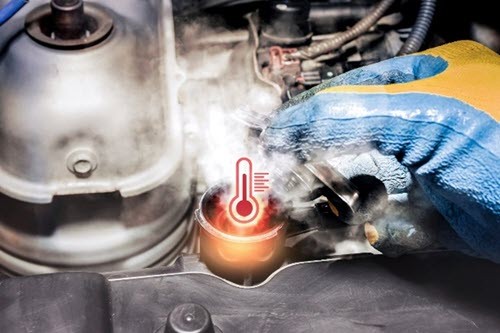The Engine Coolant Temperature (ECT) sensor is a vital component in your vehicle’s engine management system. It measures the temperature of the engine coolant, providing critical data to the Engine Control Module (ECM). This information is crucial for optimizing engine performance, fuel efficiency, and emissions. When you use an OBD2 scanner, the “ECT Temp” reading is one of the key parameters you’ll see, offering insights into your engine’s health.
What is the ECT Sensor and OBD2 ECT Temp?
The ECT sensor is typically located in the engine block or cylinder head, immersed in the engine coolant. It’s a thermistor, meaning its resistance changes with temperature. As the coolant temperature changes, the sensor’s resistance varies, and this change is read by the ECM as a voltage signal. The ECM then interprets this voltage as the engine coolant temperature.
When you connect an OBD2 (On-Board Diagnostics II) scanner to your vehicle, it can access a wealth of data from the ECM, including the live “ECT Temp” reading. This reading represents the current temperature of your engine coolant as measured by the ECT sensor and reported by the ECM. Understanding this reading is essential for diagnosing potential engine issues.
Why is OBD2 ECT Temp Important?
The ECM uses the ECT sensor reading for numerous critical functions:
- Fuel Control: When the engine is cold, indicated by a low Obd2 Ect Temp reading, the ECM enriches the air-fuel mixture to aid starting and smooth running. As the engine warms up to normal operating temperature (reflected in the OBD2 ECT Temp), the ECM adjusts the mixture for optimal combustion and fuel economy.
- Ignition Timing: Similar to fuel control, the ECM adjusts spark advance based on engine temperature. A cold engine (low OBD2 ECT Temp) might require retarded timing, while a warm engine benefits from more advanced timing for efficiency and performance.
- Cooling Fan Operation: The ECM uses the OBD2 ECT Temp reading to determine when to activate the electric cooling fan(s). When the temperature reaches a certain threshold, the fan kicks in to prevent overheating.
- Emissions Control: Systems like Exhaust Gas Recirculation (EGR) and canister purge are often disabled or modified when the engine is cold (low OBD2 ECT Temp) to improve drivability and reduce emissions during warm-up.
- Transmission Control: In some vehicles, the transmission control module also uses ECT data to adjust torque converter lock-up and shift patterns, especially when the engine is cold.
- Idle Speed Control: The ECM may increase idle speed when the engine is cold (low OBD2 ECT Temp) for stable idling.
Deviations in the OBD2 ECT Temp reading, or a faulty ECT sensor, can disrupt these functions, leading to various engine performance problems.
Common Symptoms of a Faulty ECT Sensor Affecting OBD2 Readings
A malfunctioning ECT sensor can send incorrect temperature data to the ECM, which can manifest in several symptoms, often detectable through OBD2 readings and general vehicle behavior:
-
Engine Overheating or Running Hot: If the ECT sensor incorrectly reads low, the cooling fan might not engage when needed, leading to overheating. Conversely, a consistently high OBD2 ECT Temp reading, even when the engine is cold, could indicate a sensor fault.
-
Poor Fuel Economy: An inaccurate ECT reading can cause the ECM to miscalculate the ideal air-fuel mixture, often resulting in a richer mixture and decreased fuel efficiency. You might notice your fuel consumption increasing without a clear reason.
-
Rough or Erratic Idling: Incorrect temperature information can disrupt the idle control system, causing the engine to idle roughly, stall, or have unstable RPMs.
-
Check Engine Light (MIL) and Related OBD2 Codes: A faulty ECT sensor will often trigger the Malfunction Indicator Lamp (MIL), also known as the check engine light. Scanning your vehicle with an OBD2 scanner will likely reveal codes related to the ECT sensor circuit, such as:
- P0116: Engine Coolant Temperature Circuit Range/Performance
- P0117: Engine Coolant Temperature Circuit Low Input
- P0118: Engine Coolant Temperature Circuit High Input
- P0119: Engine Coolant Temperature Circuit Intermittent
- Difficulty Starting, Especially When Cold: A faulty ECT sensor might incorrectly signal a warm engine even when it’s cold. This can prevent the ECM from enriching the fuel mixture for cold starts, leading to hard starting or no-starts in cold weather.
Diagnosing OBD2 ECT Temp Issues
If you suspect an issue with your ECT sensor based on symptoms or OBD2 codes, diagnosis typically involves:
-
Reading OBD2 Codes and Live Data: Use an OBD2 scanner to confirm fault codes related to the ECT sensor. Then, monitor the live “ECT Temp” reading. Compare this reading to the actual engine temperature (if possible, use an infrared thermometer). A wildly inaccurate reading is a strong indicator of a sensor problem.
-
Checking Sensor Wiring and Connections: Inspect the wiring and connector to the ECT sensor for damage, corrosion, or loose connections.
-
Testing Sensor Resistance: With the engine cold, disconnect the ECT sensor and use a multimeter to measure its resistance. Compare this reading to the manufacturer’s specifications for the sensor at the ambient temperature. Resistance should change smoothly as temperature changes.
-
Checking Sensor Voltage: With the sensor connected and the ignition on, use a multimeter to check the voltage signal at the sensor connector. This should also be within the manufacturer’s specified range.
Conclusion
Monitoring your OBD2 ECT Temp reading is a valuable way to understand your engine’s operating condition. A healthy ECT sensor ensures accurate temperature readings, which are crucial for optimal engine performance, fuel efficiency, and emissions control. If you experience symptoms like overheating, poor fuel economy, rough idling, or encounter OBD2 codes related to ECT, investigate the ECT sensor and its circuit. Addressing ECT sensor issues promptly can prevent more serious engine problems and keep your vehicle running smoothly.


